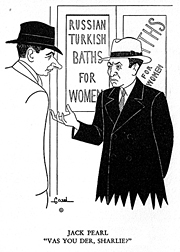Happy Juneteenth! Cladrite Radio is grateful for these great Black performers (and so many others) who have so enriched our lives and set our toes a-tappin’!


Here’s Chapter 8 of In Your Hat, the 1933 tell-all memoir by Hat Check Girl to the Stars, Renee Carroll, in which she shares tales of by the many celebrities she encountered while working at Sardi’s, among them George Burns and Gracie Allen, Eddie Cantor, George Jessel, Norma Talmadge, George Raft, Wallace Reid, Ginger Rogers, Douglas Fairbanks, and many more.

A STOOGE, in Broadway parlance, is the assist in the act. If you do an accordion routine and a heckler is paid by you to annoy your act from the box, then you’re probably Phil Baker and your stooge eventually becomes as famous as you are. Witness Sid Silvers of Take a Chance fame.
Broadway is full of stooges, both in real life and on the stage. It may sound strange to you but the jester in the king’s court from the time of The Erl King (I don’t know why they insist on spelling Oil as Erl) has been brought down the years until now he is labeled “stooge.” His job is to take he hard knocks, furnish the opportunity for the gag to be sprung, and appear the perfect fool.
When Phil Baker, who pumps a mean accordion, opened in a show in New York and had a stooge in the box doing the regular routine, Al Boasberg, the gagman who writes funny lines for a dozen or more comedians, wired Baker:
| LIKED YOUR ACT STOP THE OLD GENT WITH THE ACCORDION WAS GOOD TOO. |
 “Here’s the muff, George.”
“Here’s the muff, George.”